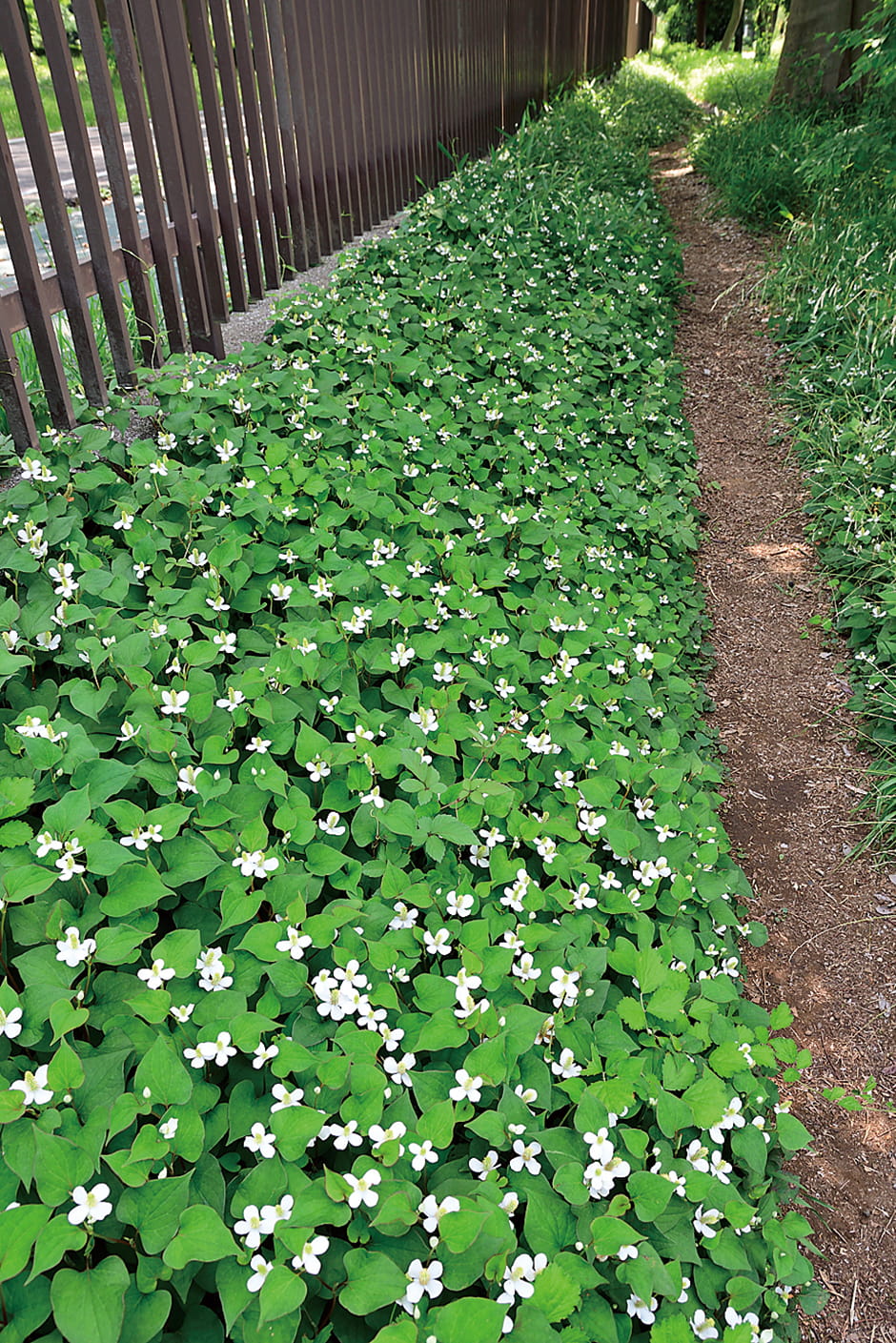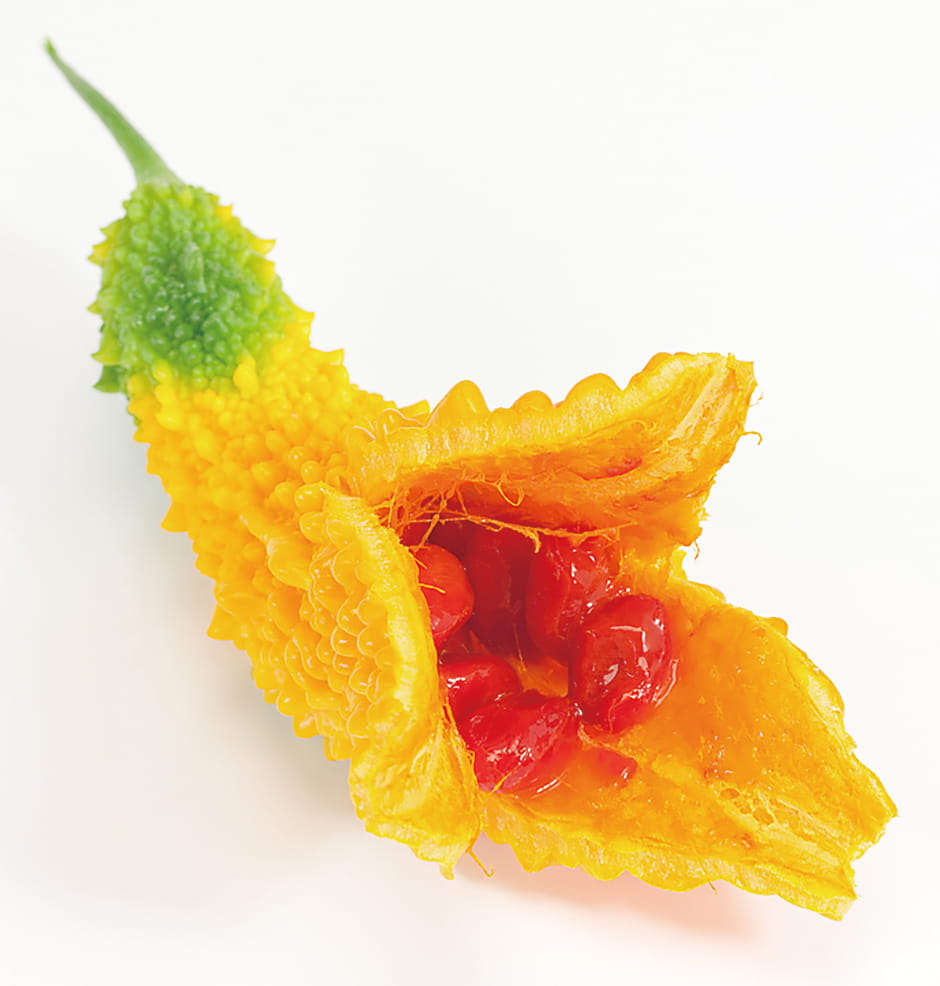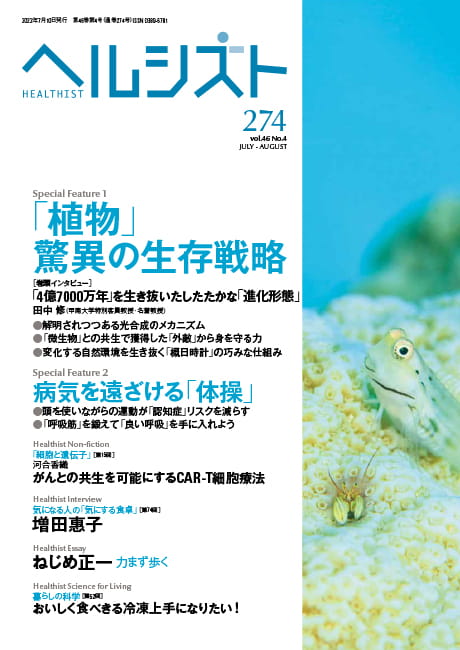Plants cannot simply get up and move to a different environment. However, plants that have adapted to the environment in which they have emerged and expanded their habitats via methods of reproduction that ensure the continuation of life flourish across the globe. They have the ability to produce organic matter from inorganic substances by means of photosynthesis and their unparalleled productivity helps to provide nourishment for animals. Charles Darwin is reputed to have said, “It is not the strongest of the species that survives, nor the most intelligent that survives. It is the one that is most adaptable to change.” This statement truly does apply to plants.
Special Feature 1 – The Wondrous Survival Strategies of Plants The ingenious modes of evolution that ensured plants’ survival for 470 million years
composition by Rie Iizuka
illustration by Koji Kominato
Plants are organisms whose history on Earth dates back 470 million years to their first appearance on land. Given that modern humans, Homo sapiens, are said to have appeared 200,000 to 300,000 years ago, there is no contest as to which is older. The biggest difference between plants and humans lies in their approach to their environment. Whereas humans seek to change their environment to suit themselves, plants have evolved to be able to adapt to the environment in which they are placed, and this is how they have survived over their long history.
The ancestors of the plants that emerged from the sea onto land were spore plants such as ferns and mosses. In the case of ferns, the spores are scattered and germinate to form a prothallus. This prothallus forms both male and female reproductive organs and fertilization becomes possible once the sperm and egg cells have been created. However, the sperm have to swim to the egg cells for fertilization to take place. That is why ferns and other pteridophytes are restricted to habitats where water is found.
Fruits: a groundbreaking “invention” by plants
After more than 100 million years, plants began to release pollen and produce seeds. Already fertilized, seeds became a means by which plants could protect themselves in order to survive harsh environmental conditions such as winter cold and summer heat.
One could say the most groundbreaking “invention” by plants was fruits. Most gymnosperms are anemophilous flowers (those pollinated by wind), which are not very numerous in species, whereas angiosperm species are said to number between 250,000 and 400,000 (Figure 1). Angiosperms began to produce fruits to enclose their seeds; these fruits were eaten by birds and other creatures, which then spread the seeds far and wide in their feces. Thus, flora established a codependent relationship with fauna and expanded their habitats.

Figure 1. Gymnosperms and angiospermsThe groundbreaking evolution from gymnosperms to angiosperms enabled plants to expand their habitats. Whereas the ovule in gymnosperms is exposed, in angiosperms it is enclosed in an ovary.
Having expanded their habitats by adapting to their environment, plants now play a part in the nutrition of other animals as organisms capable of producing organic matter from inorganic substances. However, they have also developed various means of defense to prevent themselves from being wiped out, such as thorns and poison.
One such approach is for the plant to remain hidden in the soil. In early summer, when weeding the garden, one often spots the small white flowers of fish mint (Houttuynia cordata) (Figure 2). While it might seem easy to eradicate, because it can readily be plucked from the soil, the leaves soon grow back. Houttuynia cordata has rhizomes, so what you actually remove is the upper part, leaving the rhizomes themselves untouched and able to produce the next set of leaves straight away. Almost all the weeds that are resistant to eradication have rhizomes.
 (Photograph: Hiroshi Watanabe/AFLO)
(Photograph: Hiroshi Watanabe/AFLO)
Figure 2. A clump fish mintA weed known to be hard to eradicate, fish mint forms rhizomes. Some types of rhizome store nutrients in a similar way to roots, while others play a part in reproduction.
Bulbs are a mechanism produced by plants for storing starch; they are a nutrient storehouse consisting of an enlarged underground portion of the plant. Readers will be familiar with the plump bulbs of tulips and red spider lilies (Lycoris radiata). In fact, these bulbs are produced over several years and involve quite a lot of effort for the plant. Many bulbs contain a toxin to protect these nutrients from being consumed by animals or insects.
Phytoncides are toxins with a defensive purpose, which are released when a plant’s leaves are damaged. For example, the camphor produced by camphor trees (Cinnamomum camphora), coumarin in cherry trees, and hinokitiol found in abundance in the hiba cedar (Thujopsis dolabrata) are all substances with insect-repellent or bactericidal effects.
Plants use such chemical substances as needed according to the time and situation. When plants produce bitter-tasting compounds, it basically means they do not wish to be eaten at that particular time. The characteristic bitterness of goya, also known as the bitter gourd (Momordica charantia), is actually appreciated by humans, but the plant originally used this bitterness to protect its fruit from being eaten, as the seeds have not yet been formed in the season when the gourd tastes bitter. If the green fruit survives without being picked, it turns yellow as it ripens and eventually bursts open to release seeds enveloped in a sweet, red, jelly-like substance (Figure 3). These sweet seeds attract birds.
 (Photograph: Kazuhiko Kikuchi/AFLO)
(Photograph: Kazuhiko Kikuchi/AFLO)
Figure 3. A goya fruit burst open after ripeningAlso known as the bitter gourd, the goya forms sweet fruit as it ripens.
Jute mallow (Corchorus olitorius) leaves are known to be highly nutritious, but as the seeds contain a toxic substance called strophanthidin, you must not eat the part containing the seeds once its flowers have blossomed. Plants have mechanisms for protecting their seeds during the season when they produce offspring and demonstrate ingenious levels of control once they “want” to be eaten by insects and birds for reproductive purposes, such as indicating that they are ripe enough to eat by turning red or yellow, or attracting creatures with their sweet aroma.
Thus, plants are equipped with a number of mechanisms for ensuring the survival of their offspring, from germination to flowering and on to reproduction.
A major characteristic of plants is the fact that, unable to move around, they germinate at appropriate times in suitable places. How do they know when is the ideal time to germinate?
The three conditions required for plants to germinate are appropriate temperature, water, and air, but many plants actually do not germinate even when these conditions are met. The photoblastic seeds of lettuces and the like, for instance, do not germinate in a dark place.
One form of light energy used in photosynthesis is red light; plants use a chromoprotein called phytochrome to sense red and far-red light. As red light is required for photosynthesis, plants ascertain whether the location has abundant red light before germinating. If the proportion of far-red light is high, germination is suppressed, as the plant determines that it would be an environment unsuited to photosynthesis if germination were to take place.
Plants sprout when they sense a change in temperature
Noticing the changing of the seasons from the temperature is also important. When germinating, the plant uses the carbohydrates and fats it has stored to synthesize not only vitamins and enzymes, but also substances called flavonoids and anthocyanins to resist ultraviolet rays. In other words, a certain temperature is required, because an intense process of metabolism that uses a huge amount of energy takes place at germination. However, warmth alone is not enough for some seeds to germinate. The plants fat hen, sometimes called white goosefoot, (Chenopodium album) and lamb’s quarters (Chenopodium album var. centrorubrum) germinate in spring in the wild. They are often used in experiments, but getting them to germinate in the laboratory requires the temperature to be varied, with 12 hours at 20°C followed by 12 hours at 4-5°C, and so on.
If the seed is close enough to the surface, it can sense the change in temperature and starts germinating, emerges above ground and begins photosynthesis. Conversely, if it is buried too deep in the soil, it cannot detect temperature change and therefore will not germinate, because its stored energy would be insufficient to reach the surface. The seed will therefore wait for a chance to germinate when it moves closer to the surface where it can sense a change in temperature, for example, when the soil is plowed.
In plants that put out multiple shoots once they have grown to a certain size, there is a rule called apical dominance (Figure 4). In this mechanism, the apical bud (also known as a terminal bud) at the very top grows, but the lateral buds at the base of the leaves do not. This is because a plant hormone called auxin is sent from the apical bud to the buds below, where it suppresses the action of plant hormones called cytokinins that promote cell division. Auxin is one of the main plant hormones and has a bearing on leaf longevity. In the leaves of deciduous trees, once their photosynthetic power fails and they become unable to deliver adequate nutrients, tissue called an abscission layer is formed at the base of the leaf, causing the leaf to dry out and fall off naturally (Figure 5).

Figure 4. Apical dominanceIt is always the bud at the top that grows, while the growth of the buds below it is suppressed. A plant hormone called auxin produced in the topmost bud inhibits the effect of the cytokinins that promote the growth of the buds below.

Figure 5. Abscission layerOnce the plant cannot photosynthesize sufficiently, an abscission layer forms and the leaf falls off.
One effect of auxin is to inhibit the formation of the abscission layer, but once the leaf nears the end of its life expectancy, the quantity of auxin synthesized declines and the abscission layer formation inhibition effect is eliminated. When this happens, starches, proteins, and any other nutrients left in the leaf begin to be sent back to the main stem, which is an efficient mechanism for ensuring that energy is not wasted.
Once the shoots have sprouted, the next stage is flowering. Here, too, there is a mechanism to ensure that flowers bloom at the appropriate time. Fall-sown barley germinates in the fall and flowers in the spring, but will still germinate and grow even if sown in spring. As the hours of daylight in fall are similar to those in spring, the barley would flower in winter if it used hours of daylight alone as a guide. Accordingly, to ensure that it flowers in spring without fail, flower buds are not formed unless the barley has experienced the cold of winter. To put it another way, vernalization —— exposing the plant to the cold of winter —— is thought to eliminate the suppression of flower bud formation. This means that plants are equipped with mechanisms for properly sensing the timing for key activities in the form of germination and flowering.
One of the most familiar ways in which plants give humans a sense of the changing of the seasons is the blossoming of cherry trees in spring. Naturally, cherry trees, too, have a mechanism for determining when they should blossom.
The Yoshino cherry (Prunus × yedoensis “Somei-yoshino”) forms buds in summer. One would therefore expect it to flower in the fall, but if it did so, the cold of winter would arrive before the seeds had formed and it would be unable to produce seeds. Accordingly, the buds spend the winter enclosed in a hard overwintering bud.
The formation of overwintering buds is a task that is completed during fall. The tree senses the gradually lengthening nights and a substance called abscisic acid is produced in the leaves. This substance encourages dormancy and the buds present since summer become overwintering buds. One does, on rare occasions, see the Yoshino cherry flowering in fall, I believe. If you recall what such fall-flowering trees look like in summer, it is likely that almost all of their leaves have been eaten by caterpillars. Without leaves, the tree cannot sense the lengthening nights and does not synthesize abscisic acid, so it flowers in the fall warmth.
Once overwintering buds have formed and the tree experiences the winter cold, abscisic acid is broken down in the overwintering buds. However, blossom does not form as soon as the abscisic acid has disappeared. The tree has to wait until the temperature rises and a substance called gibberellin is produced. Gibberellin is a plant hormone that promotes germination and breaks dormancy to encourage flowering.
In fact, two processes are required for the cherry blossom we notice in spring to form: the breakdown of abscisic acid in the overwintering buds by the cold and the synthesis of gibberellin once the temperature becomes warmer. Thus, cherry trees spend a long time preparing to blossom.
The stunningly high productivity of certain plants
Plants have elaborate mechanisms for determining the optimal timing for germination and flowering, and for efficiently using energy to ensure their continuation through the generations in the location in which they find themselves. Some plants have stunningly high productivity.
Let us assume that we sowed a single grain of rice in spring. How many grains will there be at harvest time in fall? By the time we come to harvest it, the seed has grown into a single plant. A single plant will put forth about 20 ears. One ear will produce about 80 grains of rice. In other words, the single grain planted in spring will have multiplied to form 1,600 grains by fall. Perhaps thinking about it in monetary terms will make the point more vividly. It is as though ¥10,000 increases to ¥16 million in the space of just six months. That is an incredible rate of increase. It is precisely because of this productive capacity that plants are able to nourish every creature on Earth.
This astonishing productivity is not confined to rice. As many readers in Japan probably know, thanks to exhibits at science expos and the like, cultivation of tomatoes using the Hyponica hydroponic system results in plants that look like huge trees, with each plant forming a canopy that produces more than 10,000 tomatoes. The tomatoes are grown hydroponically in a greenhouse and the composition of the nutrient solution has been disclosed, so we know that these plants are not receiving any special treatment. This example shows that, if the environmental conditions are right, plants have the potential to demonstrate incredible productivity of this kind.
No matter which part of a plant’s life cycle you look at, you will find elaborate mechanisms. And today, with humans having gained great power, plants are increasingly surviving thanks to their coexistence with people.
The aforementioned red spider lily is a plant with particularly strong ties to everyday human life in Japan. We have already looked at the example of the bulbs produced by plants in an effort to survive. Japan’s red spider lily does not produce seeds, which means that the vast majority of the clumps we see have been planted there by human hand.
The red spider lilies clustered around graves are vestiges of the time when people’s mortal remains were buried in the ground. As red spider lily bulbs are, like other bulbs, toxic, they were planted around graves to deter creatures such as mice and moles that might injure the corpse within. The red spider lilies planted on paths between fields or rice paddies serve the same purpose. They were used to deter animals from wearing away the earth, which would have made it hard to determine land boundaries and allowed water from the paddies to escape.
Today, a substance called galantamine, which is found in red spider lilies, is used in a drug for treating Alzheimer’s disease. One symptom of Alzheimer’s disease is a decline in acetylcholine; galantamine suppresses the function of the enzyme that breaks down acetylcholine.
Looking at the way in which plants are found in every corner of the globe, the major reasons why they thrive would appear to be that they pursue harmonious coexistence with the environment in which they find themselves, avoiding unnecessary conflict, and that they always evolve in ways aimed at ensuring diversity. Ensuring their survival through self-sufficiency and self-defense, plants have extended their territory by evolving to suit their surrounding environment. Darwin, who studied the theory of evolution, is reputed to have said, “It is not the strongest of the species that survives, nor the most intelligent that survives. It is the one that is most adaptable to change.” This statement truly does describe plants.




















